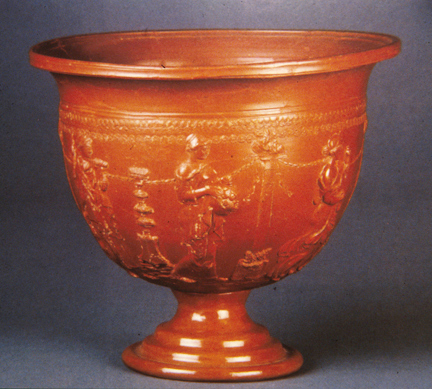
Stemmed bowl, Roman Arrentine ware
100 BCE - 100 CE, from Arrezo, 18cm
ART 198 - HISTORY OF WORLD CERAMICS
| This bowl with a pedestal base is an excellent example of what is called Arrentine Ware, or Red Gloss Ware. The Roman city of Arretium (now Arrezo) was the location of the production of this ware, but later the style spread to other sites of production within the empire, especially Gaul (modern day France). Made of wheel thrown terra cotta, with relief decorations of rows of beads, wreaths, rosettes, and figures which represent the four seasons. This piece is signed by the potter, C. Atieus. From the Greeks, the Romans learned the art of using a deflocculated slip, but preferred to fire in a clear-burning fire (oxidation), and did not use the alternating cycle of oxidation and reduction the Greeks employed. The Romans called the technique terra sigillata, (literally, sealed earth). The technique was introduced by Greek potters immigrating to Rome, and who taught the technique to local potters. The decoration on Arrentine ware is of Greek origin, with figures such as maenads, satyrs, and fauns combined with decorative filigree as seen in this piece. The raised designs recall those used on contemporary silver objects. Molds were often made from these metal originals to create the ceramic replicas made at Arretium. Technically, this ware is the most sophisticated of all Roman ceramics. | Stemmed bowl, Roman Arrentine ware 100 BCE - 100 CE, from Arrezo, 18cm |
|
|